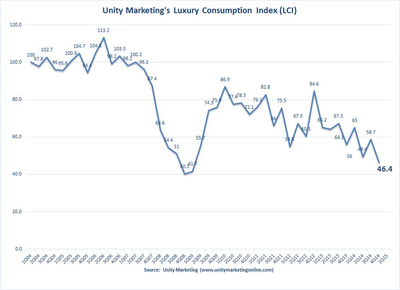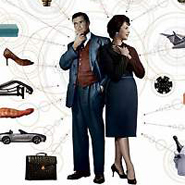Most affluents tend to shop in-store, but one-fourth of these consumers consider online a better option, according to a new report from Unity Marketing.
The "Trends in How Affluents Shop" report looks at the details behind the motivation, manners and thoughts of affluent consumers and their consumption habits. Brands and retailers with this knowledge will be able to look at their top consumers in a different light and adjust their marketing strategies to benefit the brand in the fourth quarter of 2014.
"When it comes to marketing to the affluents, their consumer confidence plays a decisive role in whether or not they will buy," said Pam Danziger, president of Unity Marketing, Stevens, PA.
"Affluents have plenty of money, far more than the average consumer, but consumer confidence tells you whether they have the willingness to spend it," she said. "The LCI measures their confidence and in the current economy, we find their inclination to part with their cash depressed.
"They vividly remember the recession, learned lessons from that about new ways to shop that get them what they want for less, and they are still using those strategies."
The survey was conducted from October 9-15, 2014 among n=1,330 affluents, starting with HHI $100,000 and above. The demographics of the survey sample was average income of the survey sample was $259,000 and average age 47.9 years. The data was compiled into “Trends in How Affluents Shop: ACTS Shopper Track Survey Executive Summary 3Q2014-4Q2014”
Trending affluents
Affluent consumers make up 20 percent of United States households, or about 25 million homes. These households account for more than 40 percents of total consumption in the U.S.
The total number of households has risen 2.5 percent between 2010 and 2013, but the number of ultra-affluent and “high-earners, not rich yet” households have increased more quickly.
Personal consumption expenditures are steady among the affluent population, certainly up from 2009, but not as strong as pre-recession numbers. The third quarter of this year is up compared to the first two quarters of 2014.
Affluents have reported that they are less confident than they previously have been. When asked if they felt better off now compared to three months ago, only 24 percent said that they felt much or somewhat better. This is compared to the 35 percent that felt this way at the beginning of 2014.
Unity Marketing’s Luxury Consumption Index marks the current status of luxury consumption at 46.4, a number that is only 6.1 points higher than the index mark in late 2008 and is 38.2 points lower than in the first quarter of 2013.

Luxury Consumption Index
However, the International Monetary Fund made predictions in July and in October for certain regions’ and countries’ economies. The U.S. forecast is the only one that positively changed, due to world sociopolitical events in other regions and countries that have been negatively affected.
For brands and retailers, there are three perspectives for understanding the affluent consumer, demographics, purchase behavior and psychographics. Income demographics look at who can afford to spend, purchase behavior tells how their money is spent and consumer psychographics examine those who have the willingness to spend.
Ultra-affluents are a niche market for brands while HENRYs are slowly emerging as the new mass affluent consumer by looking for more return of investment, like mass-market items, but also the bespoke services of a luxury product.
The Internet serves as the top source for affluents retailer or experience usage and ties discount department stores for the number of shopping occurrences, however, shopping happens more often in-store and more money is spent each time in-store compared to online.
"Too many luxury brands have ignored or miscalculated the role of Internet shopping for the affluents," Ms. Danziger said. "The internet is a powerful consumer tool to get what you want fast and easily without a lot of hassle.
"Shopping in the store, on the other hand, becomes more of an experience," she said. "Sometimes people want the shopping experience; many other times, they opt for online. For luxury brands, the internet is changing so rapidly they need to pay attention to emerging competitors at all pricing levels, and look across the full range of offerings online."
Since consumers are using online sources, it is important for brands to be able to entice the consumer to go in-store and physically engage with the product prior to purchase, this will likely lead to more purchases and a better relationship.
The shopping experience also varies on the type of affluent consumer. HENRYs might find shopping relaxing and exciting, but older affluents find the activity to be something that has to be done. Also, men and women differ on their shopping habits. Most shoppers need a justification to purchase a product, or are buying as a gift for another.
Bringing in bricks-and-motar
Bringing consumers in-store is key for brands and retailers looking to engage with consumers and see higher purchases. Some stores have tried different tactics to bring in their consumers.
For example, British fashion house Burberry celebrated the opening of its Chicago flagship store with a physically- and digitally-immersive event that showcased weather and city residents.
The event showcased Burberry’s Art of the Trench images featuring Chicagoans wearing the brand’s iconic trench coats. The images were shown in the store, around the city and across the brand’s social media (see story).
Similarly, online trunkshow retailer Moda Operandi is expanding its reach in Britain with a new bricks-and-mortar space that opened just in time for London Fashion Week.
This space held designer trunkshows and curated events, as well as hosted clients. Keeping a level of exclusivity, the physical store was open to consumers on an invitation only basis (see story).
Integrating online and physical experiences can aid in the future of brands and retailers. As well as looking at affluents' spending habits and desires.
"I think the biggest takeaway for luxury brands and retailers is not to be overconfident," Ms. Danziger said. "Again, affluents have come out of the recession in better shape financially as wealth at the top is growing, but just because they have the money doesn’t mean they are looking to spend it as quickly and as fast as they can.
"They didn’t get wealthy by spending, but saving," she said. "And today’s affluents especially those 45 years and over have plenty of stuff. They don’t really need any more, so purchases are totally discretionary. They are picking and choosing more carefully. They are a hard customer to move to purchase."
Final Take
Nancy Buckley, editorial assistant on Luxury Daily, New York
{"ct":"bIJmcncLczLi4Pvdue\/u9kVFpxupIlVeRPyhUAXqrybBC4g9hcyIj8JKNM7A5fE95sWiCtL3u\/LMcUqW7dUTSO\/JfxjulzZY5e5K1H4KiIs9vEngH2cCmrPXUVSo3xRB5wCimgi3Jrz+NufiM5H\/0n9YpeXV\/w\/f+SPN5RiumlmfoKbJ2tuZ6tUf5LpnfYn7+enFqLcyv2J5RNIZuvulIe71IW4LwKSoOX6mUppLag+4s5IDiXvsTeE+o7ho8hDzwhTtDqZ2N5ZR0vpFK6dj9LKb6jT1umsEFRZ9KX4aLHdkHpb0cMDEL8eFk2nktrQOhbCVtIma88ik1+YuPDMGgEVyVzXTvvRHu6CYl5UWyrJy2IB8UqF5sP0joIf4CjPCJi0dVsRRq4pPJidlRt5pibqKQW\/HUunZK+c3+HPbBAxise0koFJk2gD0\/ehOanjvFc6dqzHpMnuZPp\/hmoVwIK9+nrBiHvni1u0Nr+U3H2nWiR1g6QO+X3mukiVC3XTMWucm9i1pQ9fNOLVxCIlIu4jKnRoBb7c\/\/Avxh6Sh\/miP49woTbC75odtE1Dy8Ht+4SHMrjgkdhNpzporL+47L\/0inLtKOwv+PsXPex3OD+vx9qL7Ej8OpsT+cagG2irnXNmBCfPbXd0IOheHMB38kEL7kvhlOyvwAFVIA3ZPgExyJMEBhGKIQ2biUqIWlB+RouZRHOnMpwTfNMUsSsW9RK++xY+vcTox+pUJcveZHcMizoBwv9APoEfksXLRDoThgQHdrU\/A7VCsmMCAi6c\/jUQnglJlfv45rJACCoX\/rXRGRnq+XefgbKvNoYt4tNyufydMgXY6irCBEtRQPem5Q3WIdbu6Yx0m1rjWy5xrcQaPViV9cCBWAGZneEO+gnrI6uOTir6twYSQSGwZC+DKXWtkPfeSvG\/YnXTslI2wWhXtuHMblYswOWg91NMp6tEEhH5xLlE2V0W3YPWsh6TIwfQDfb9TTslOLormwoEAUe3BRMU7SHHNsRHA41uD80ggGt8sLmWxbuZjVt4yhmt+pASqAsBA4WKBm61g1JYOEv6RKo7U6kRHihSpJbN+ibNbLnxp3tnpb4OhJ7KHCNN5hFTY00rUevcKn\/UTG6TiX+tKZxT7xY2d2AAty8AJbwG0GQii7Kjy+C\/dPgXf9TCkWrWTD4sRgI0NgJ0udW8Q2\/p+qfvc1P9M29Za5lgR+gimWRpWFSeWPNvTECIIKerDGCHzFzRLzTcKKo2kH4uM3e9\/5pqm0yOalumWGOS7I070I2O3ZqydGapOwfUvd+Dr8iC9qFUxivjDcZpOvIgepmQLv7VHMmjVRNUvAmNDKz8i0+LXU2k2VPFrVcklhhRdEjVSnVaaowNxB93OSZjijg2pWKU3sMKciLMsslblABbmRjUtqvSlHBp3ibaKNJmovu5jZweZkqmfIAWtqsRqJItSkUTZjiXZntRA52x\/Zt+HFTqcIQfa021K17YIRNjOU9KadzAj3ufEtnafM6gP2\/fmVlItCqFERNUmmlRCQyjBewRpFPHASINupodCY7qrhRkcT9dykRz\/4\/dZTO+CkHAJgw424SrXkql074nenYXW6dDZBEPY\/ifWyjNkE1cuVakRzKT0CyOq5n8JkY8+cm3rStt2EU3bQf9AWGYl52ZLm\/IWCDcHpOxLuGFbZU86DTiIh6U1y00c8SOZXW\/hXku4+88C8MGsb\/nOJ+FrWPTOkvyImM3x1W89YTZ5FVqlA1fi7H9s4zIOOnSQMOF8BupN1whTdQcCw0NiYDcDnpCIHYYslBg+lYIUUqtA8dCxDoQKYSGpoUE9fCKoTD4VHOzAGAJ6xPDrpY5yX3rLQU7YG2F1gWthVnUDPXnGtE5p9PMSf\/0Zr9hVQRD1lWWfS20L\/B2n1o5WLRILINq0zAD+FW6fPJfT5uSfiNguvb\/YaTJHi\/BwF75DJ2cR4djgqJYOo55nNTrRgR1wF49UDEjJik0EOJIYI9e3Acz8YXncqMldjxBAa5J3jn4W6Alqp9Zsq4+2F8HHH51uTuBuG+uyNQqpkw1MbO9AFgnloJpFtTGHOeV3nDBd1zgR9YCwXAjCPi9rc9gork+TlOZV+Nubnj42cjV\/VGcaaEh32mOv8xKkzxJ9d2oR6JPrDLR2Z60zSGFKj3HDtyRfRSkyHAPJhLIFfCc8VsbrwU1E9HyZ5gQ13aoOi+VwzPPYUbZZFSTZFfCLvEbd9+fycJ8YHAlqfuH\/cdG4IUDpbBr334bkNsxRpVyC1n3EYYZWA+fE84B6CfVn07KVDKJ2\/qzn1WTLILJFHFQ4RbCsljbRk2hrjWSTNpqpNsoIquSXUi+1Dt5i7YMSlAYavVBHXA2MTxzEJej1xRplhrLG1YDsy3F2i47yuuj63Zsy8NhqkPQ8rvQmg3SNr8Q5UuTT62L7cCgDVTLKnYBEOUbSXa4Qn8kE7053K8UceljH3MAJDooax5vQr8h2lCsBzzl3APhMuxXe1dEiYGJs9lekX3iNs2d+kfoATHFvj\/0dfqzpirt9FCBqrSjAj6yY37oHCJtiEzxTyGt6RyybgVEmZNUWjqMBpr2cW2fcpJHU4UNpNwQyB61vGCER+jYUdYivnRkFIpj59IFOORpzS+LEX1Asi7NLIZabrP3IBLlFSf6x3lhAb8HJ2Dmh3m3B9cDWzG3pca97XCHPxYA0MgTzOuOp3m1G4xjaeV8w80a1iUmGw09QVNlxKzN3KGG06u1qoZlO8816PPYHkz1Qw35wnAf4bjxh48AhSPDrtv7f3hhD6A1k79q1FOsoQuobp+G6l4N9e8bRbMFp\/iE2hZ9EW60FO\/LCoWSeHx2N0UspfkAYfY2lFjZeabpRwWEXEA3HpkGnM5+8\/rDIEuGUEOWTwxsP8d2I11sZHDvseXyD7jOTtFJVZ1d0VV492OfKImD4yB6SMZxPDI584ucu2pANKpase8MGdkqG5agKwRzGHbCOY7rz+dD9VTZRXH9BjXHhw3KwdmiF6BiGOGyIembg4dExwMVraCgptTjXkQuTrQsQ2w\/KrRetg6jYEGgmQf2ph\/Yomr\/5SSmsaH6HGSnGNLR7XLIIbuVUrvBqtpkPIYX1umQGr+hnrL8bmPRUOEn\/DFZcF79z7GKAOukOef3JMk3cATmmqE3lIWeyXwhafQ3mGfCZmeOY\/rB1daEqlaLmbXebmyu90SGtNyibGWFE1uJGEzy+DaYku1xpPHPr20NLeQuwR9EWjVLff\/UteOpqIHtleWR+k4uZB57CQe2\/wYZJxmsI3y6cqwDESnQfd0s\/y2SUjEkDIyigT8+VyOJ6VToz9wrMy9aMvgFbQ11xacfPhAXCWO3HmFae7fEmFzIx5CZaYodL7cDdvyHKi8CxGwtIb7H9MOhh0Ol3AcGigRX5hmG9caP3VEEhcu54bA\/tL4f7cxhRfJ0MfdLoPPTuvYl7iBA\/CRF2vruaBMxG8cj3g6zUG9L5O1Vr8YQbv+Zj7SbsTh37e5J7R3scIq+Ojp6Va+5qO8tbB99xgJVKby44anf9B0bFyX24aksxCVbyzEdfnSODW87w5F6nX\/G6ZyrYwqiElpPTVWGwdTrjU\/L6EOiETBp9T7KTPRWOazLHFfMyqJhYNdK0rYJhFzlJhyvA7VuyYL7UsDe5eZJcSELtQ7qPmSf8\/y5ygQ4\/quvnftGT2JFbcowX9dZKfnTN45sggKgQKrDSy5wjDUxWuLXzpZ+WFu25bo0waTSMB9uDCKw9jBTTs\/16E2W28zoQsjo265nWcB21mrdW3VgF9bKtwnpeIpp\/5EJNUnFsQockHTNuiUKEzi1fc42+InDSb33yzQnWO96ECxwCEVqlX20iwgLiaU6HUVDKvca3Iq4yHxFUyxFBWAKLH646LNyb555NC4J8cxiO945eOIRXRSC90XcjMMeIJmapS2\/domWMDrbt04l3lTgHgzbB4YW+t+741IJVGxD4QGYr9XFrSDTrkq0Df83RgxhRksfdxfSVXnsvK26KRS9YVVb3KFBh6EdKBpk2ybmcby4W2XwheyczuFZdsmsuX7\/SxqKdaJ7XFMH2ECFnZ5htauNJzUoFcIDN5FOIAoaRpb4cv7oCD1B3v9s0bSlrh1NYQrMAFZjLm4dbIeSYGLU2iBQey89uJOkPP0ta+XLBWpY4rOLS+xGVrooNvZn+B5c\/ERwj9Jb9Um+z0S42XoseGUU70zrETiFq7de1q+CuZuJ5rRWkRDN7uljwT31DfHz\/gJ7Km2QMEvCMoBIXSzT6xKLN4NzS22mb7YczO1LfztIUTVf5i5kSKruJdXZji8glChP\/vXYIt1HOtrPK7f9beSv3yOHWQgZCTzSQ0qhNBa7xsxgR\/8Soy1TiwLGCmuXsJbxUsY3BZpoMMVr3349xPgxyhKpiOJdq4bCn+n10MDaCedZGG0MZ3zM2JWJxy\/pD+\/\/CTV7onmXpJZPwG1eEiqj5yX21r2OGgJm\/iFr7qXVUfBenqPUaSSptdjw65u7ZOhL5qNSCvAtoCA0GXjiEdM4HcixKX9yUvjAQKmoA1x\/n0M5\/s6wJwmNKiIEEgTqYZepIsjP6dgoik2loyW\/41r8AE\/lm86PBH4IkwHDDzMDF9JbLBuc+FtQCZhWFq+IOOyyxYHhzbNWNp0fhYgr4I\/OYBIQTeydWWhoBbC84F8oJLPoEsKXDfcQp5m5fW0GuZ7W4RsA7RN2GunW1jNSYfpmRiRSj4qJV6aaN0il6dPysaV4moqqN6OPNuvPWHrVVUEaZ7Og\/uKQrmuW4evA+e6Jsip8+sFM+WWqhSXkqmtMwJ5OuDi3e0SzBXiCCtdUoSoyR6oEXMUDQ6Q7XNIj7gV1ZvFmPnsR67mIcn2DtntaVneedZysIgz+g7mZiZVYW\/hZ8Jt5VTMh96q4BxWKrsycoSdiY966AnPo\/vUiwB+v3psNttyn7c8akPV1QaSDaZ4iiTjlSEAcAOariuDw2nfgpJxKps5czJW92GzWXOJr0B9P2\/KuhFy2OSS1o3gbSb9r1lwY57MqAU9UPIwLGSGLYwiRo2OeMOqgEA4qB0tcIHrcXeB4uDVVvJaxsVDXqW9C48X\/UMpIAFP3OOIhfElSTq9g8O0xresIDWra8ZHYGsBvcMl0gvQrRoqree8DXY9W0i4yZQXlEzGA6t\/zJcRkxeuW4DLxPfBwNp2V2+f4McmRt559+pkRWroWuvVwXZIOFIdm\/+MevJIIDFcLttsXGYEjGUrHymN2AdRJGfYtPGquX\/1m5PYCgkdWetmKj\/si9++\/EXKz6wiMZp5jxAcnWdtQVg4XoMyW2KaL65na\/L8eZNYzOuI52BGXQJrvqvawys0uGfnUUH42ENClMLQtGLwiMKg74i29F+HMjeYfbDD7EOexngkC98ZuJXhwTW3yniRoyHNEIFSfaZpIibQ8wuBbZQyN54M2r2P5noGuHlOaqDxR\/socqYFV0n6CbaDlRsCMbpDRBybSVIkH5Hounq6qRzadZhJGfH9hylMsSblofypgXSxRZNtive2+0XH3nqa\/F6HhxElQf8g5zmH\/nIy82IIhtBTO6xKnpc7nQivXRxBFOxu0tTP5kyOE+fcPXaAs9FgG8EWz52zs1yrkY7aOK1G7KDBUt1csaAjfsBC4KPAT5a1ApiXvsQDFpFaGqPzlDehbNyZ1osqEqFmKB1on7+P7X2P+xZWOMlGHrrrEfbTnQrtFrdXHQA95gzfLhxEHhV9LP5vdeWlQg1mAT89bbkOVjJnV84LDQxV1lyOdYE8YE6go0sAKOGurNSzH6zpEI2JujqwVuYkON\/+mYcJPGhsMqe\/sBi9xsZFEtVN2xk178Qvv6eU6tEKowNKkqZmT96h6zCJ31QsO8FBDgO4oBggh084WC06RqsZIkXW6RKLvfSWLJMzgigLzqbYcBzMpu9B82SXEKKq3KPTVl5LxXI\/fsU5qsC\/pW3xq72B3Y9cdb5v6VAhIIaHpSGYmigNt4Q\/M3GviC9U0U5bJOpGkDyROpIYl8Z8\/UjSkVz5HyE5k6YYWFTveH29TEmLcYrmqoI55l4g4vRbMub8xe4dGbffM0OY1\/l62fkB8XILT8ii8R5TOffiQ3RUtZ8zkc+\/g03VbKnXdNR2TRbV2moX6ypEw1h6DVAJVvbtKCckFy6IopIka9TcI7ZX4v7SGI6VA0FwxNls6ZKk4Zax9ViOOLCNqIvP+85yuPhu389Aopt6TqqRu7ZyZHVUSCRKRYrewY4mzKyh+yTKlBh+JwKQ9j\/ipohWurI9aUNjmePgUm\/jA7ObUN7\/e7NwenqD1eXBS1QZO1TfFd3RU10gOHKTRGvI8ZWlMc2dIplRLiu9RnehK1WvpOifeAPD1wi9\/mt3kE0ez74Vwhf3EjJSHsIJiWPXfh2QL2YZwyu5Q7lwQwqIuEKcmP65Yv407OtYFKdLtV\/KBG205ZRBJuhINHRtUn97Ms\/YUl1fyU\/+dj6fqRuwJDkJT0DzzpGCwtCkPmaIOmY4P7GKp4ZwgGD\/4z8Ij+QyMnAOpux+FLPqAjpfmt+oOMPh+dqMa4XGWEQIE8x29g2e7z5pAWqDk6dMaHvE1pK7QbtAQcBl8B3smWUp2ESerdTDdItdrHaeeBncOy0atjpvdJYPViyui7lA3gO5znNyzk3ebXtRl7iAtm7KxoS7YY1qM9F0eL2YnH5OjzO6thXsiIBQP6Wru5cMjIZ63ZRMOhq2YTcVP4fzQHqeh3sx2hNIYFAMaoU5O37vu08jBXtXTkzR0hlsRNTrTMU9Aw9A5enQlV3vwwOxpn7pVxdT3OsY29EVIGio5lrjYeOBR6+HK56hrBcgr9aVXLmI8gRbuA0vs2vQT51b6tOXDz0HUCMjZ8J4BDXOQCqDLKFFlrx3ctYQIBdBfQ6Ja8iVWxGc6DPnqs72n2LV+l0aRi5sxl+YQXqzuYK8ombwDYchBTnITZXtf9vTbgn5HFopokxC9kN1AgBzxJsaU7zETW6Ho7YAvSyCVfN\/Ki4le3OHGi4I8xnh5vxqGlGMZORy4B+8W561P8Zhnin0FaQWwA\/4eae+O7UmsX9\/eQsChEWi+7ouCf\/oa4\/\/pvsP+CbTReWisVsHOVTKc1J2EDq3T1wkjgbabG4I\/5\/kkseLXvy0Oo\/0TsSWA+mDXF4aPhhJPkeQsGQoz2\/Pjamsf3xh87EPNKhqclVFYAEXkl2KTxlPbUyUMLNK+SWA\/vnGs56ciGIeTop\/42qTvGICiuYcBBHWXQyRS7kgbzBVrRRHrLsFS\/MhOmM8wjuqWqcDU1CMzx4LunqpcSVR9t\/C3KSK3nJXI794RihQk9m6Ipyu09yT4hX4Txpjw7mzKnHPi+ee7hp370MNtXdgDY4LUYAEUjIYe\/EdugswNQv2cj2IJsS9ioR+ZuJlzvhJ21RRBsuOPBboqCOuIDkY70cr4VDHsXv5uqdvtGTebCWr6gHvSrBxrMyJAdljgmFoXwQLie8YLo3Tmk+nsvFiXvABSNtJ1z71PX7R59VzjsLaCidrTD\/sCHIbbEOYI8yGR21vRe7x5lpz9ZxPqEpZEokghYgcI9tvCZyEfIMGUB7YfnI3BYGWO5aR7avQuTQHpcn90C08Agw8Xfo0o2zrMuesAj28yLlMfDk1xg2KF6mzeaxBSFqt7ImUxzkjD8vu9reoYSz\/JYhet7C5WiPG7UFx9y4JnQqjoAtisZPJAIch6GhOtai46knt6mMEOBig6i8g6eLn2wJVErernwtOi+3Gq0Ngu8JLIjxM\/u8WI0QEzM+wvpSBJx6nIWVS3pOsxIe7rlmsy29XiyH7YQGgZLCcHhH0X3F8LyBGaibT7aIrdXqwcMbjwpIBT5wEJ+ARjEQ+z5doLnFBdFbVwrH\/cTVC0EvFSk0UwJRGOoN8dCaUlKDAT0P9ekhKMTaG71w8y+iyhA6LkjEDryvRfMadseyTikLlACNZATZBVdV0nZhe8n8F20StXcwRdHpuy3WNPRSl4Clj2OUSTwdoVOn51msACXNPfEVL0iPp1WCX0Bua2QwtfMMz3njAobTX5IxwLo\/bV1TM\/rW0tTaSj+87xErKTsrqrllpJlD2rRNmmrUajezIfn2g3H4X9epZxw\/UK2BUMrkVwJnyuEVAmiHFJ73VMa\/A4GLbIhnydkmq\/A93PqxyOhb2FYr85Ie5fbFyZGR7TOyTJhYfg05JXIt8PNIlYAjcmolyM0ZAtxcW9pwRFPt5QzmZFd4TMwv0IB\/mUqQNKkVMxzAW6hKt1Huwy+sl3AA5yDBvpqqzi71BOLOqAaXSIvkdR7gWDh925+q\/LZm7eUduqJdBuiiePVnbLrnwgU66EMWTUe5IDxdZ339chx4iy3oCGckZF8LDkyPYlqfVE8jGYzhDHV7BhYTppqufhu2\/Qf5VNCAlrGla\/CTeOzEgzaSks+zAvPv6ntYomBEHN6VN\/CQw42ZHTMnHCGux40Q+yLdTs1s0IUkuArwCPc07EF1xFGuPszF6w\/wUkF8IQUtBqxc2S4zplHY7Htvkvocg4KLFyFw94p4cJqETCnIQPkeFZoIARCqaVxKW6+l4W1o4uFfoxLUyGhC9\/gvpvrHW+XX0dqymb2FYJ8dy2LxBKBSbY+tJpoEZ528cDLh9w+iovPTyGbN6jG9ZIUtlHxlDJosr4nVrN95kA3Up+u3wcrjMQIlXCxIgFFMG3u\/2fXNPZ6zgAOeOZEtBbU6ggBrY9zsK8WJtLt9KqTsUws1Az72P09LJuefl5DEdbFtukBDlZvCP9sWd\/LG0NY\/B5WwSRZy0cI9v8o2xcbOZz7MqOUJKZX1rl+ShuGEo+b5lOwiwmo6Zeruh7NXIMW643eKpClRWXmNRQP4guL87wDp+bdkk4iRXfV0MeDqdW4Iwv9e0Na0zWlRi5GOtadzYo8iv5QErT8br5i5IhSOWFOA9L6cuyyUipG1dwClltVXkn4rV7dSJKie03lLK2duanp+Bd78I\/kJ\/3jyK3416sJusL3Ah2mcOAXz3CgVNHK7guhyvmxRM907kw92GSBAP1HnCztuFqqXJp2VOQibhJYbwjOjRc9p68z+rcrvaeIhJGd8cAL6M3YvDdIByur3S2f4xBXuhc2LNKfuU9VsHkkjIAeKVdcQgqikTk1p8NUlFYdZlGYbHp3e8DkvytvUNJqBVHLELzAom87mMjK9CBXg559dQMkwHTyUg4fxjLihFKUhfH8I4yneENC4PABQu25EGeZcOf\/E7HrISjp\/HUyhG+nIOoU5HNjHbCNgfjOzldGpwDwDZ40IMA3qWh1VOtGYaRNTftaIRUCKiwZ0VEDqPG3O2eEU8Ne\/6R426SS9Rm1vsAzIpY9FdDTM8De\/zioeQIKeskwXOe5aqCXodWNlY60aeQNDJbxPVK9o\/WfsbPoklHqPKovezGpVs7ahXYnm9X9bxD\/KviKYoADYJRDWnxWNpO2rIlDGDPXhDtKBDksGIYZbqLAdV+lOffWn18V+H4elG5g+U385RQR9To95acVaXPHT\/cGbJ0PlNzmkClstQeY6kde6JvFc9qwNZ4r5pMhcOz8RAMREZsU9wO+3xmVPZCl9Lihu9FBqt\/JhAkQB9DH9LxHVZmrWUPT0hW6zc10w5l3Dkunmq\/26kxNIUYK4J\/zcF9RxVpreyLUnNr5O7TalWb18kTi55h9mfCa\/tzIvk0axohPRmQOJdEHiE+Q2xQn2VxU1Z4xRED4zZdXp9ubTPYKUiaWIA+MdDLHXruf6XMEYVDgODOC+oX3KC0pY8oxkKcKjjjcsp5hioJBruf8iHpKc6uGAvwHQ6w6D\/Py0lQnaJMzcU4obWiAlqcottmVb0pt\/1XDjRQtNlceR1cJDaXF6hbkIiTkl\/We48kWaEn+ONfjG0IrUEqr9F3trWaRZ+7KA6S7ZjhZjnjgtQZ1lhW73hRjN22\/Ai6Si+RI9DGGH1YpP4d7T4uOWUw12p2plcpG4fZmVE7napRpbIZ1BPzgSxohQv8M8FJF7qc+BlxXBmcz+K4fKoZclIzWKHlpBXsF\/yozRpVyq4o3XSSL\/GPotGrU0ijcOGuDzW\/hTANY\/4IWUUnEZ0GUur6JUUP+905ySfEvHTp5GJbucFI1g8omRR9l4142JsMj1RAaMz0aySvRgj0X1uY5G2QtTvxI10Nqk0762+O3nMIkdor02GirK37nO3efyuC728nde4lQXDaWFnBBsqwnma4d2qO+86LwmrgBKYZm5WELvPyTwsPojEMesynNWDQcRDH4yGpCoeA6cxaRZ07\/ckL8PKfVHRs6NRhhhCbbz2uhpq0NgV7gyl3p24NdjeAcnGyfe1g4223S7eGMBQG\/3dyBhviTvBvrjLWgdeAkLVwKGFOBBZJ3THBV+\/SVIVpG\/Ks4xNd46e12crknjFWBebnLj9iCzImsjsE2jaMjG46tiD4cC+6ttuiZRltj\/3fZIwUIYsyDOc++smJZt2TLI1Hw\/ROXLXpj5LsIoJ\/BnpSbRtQ9d7i1EjS4wt3nRZOUsLokoMpR6dSHzIFiSGCc\/kXkMUhF\/2MWIMgk\/QOOggc5c0FwazaWRCnGuNAxOiUnLfKo+lHfx\/JFrZA81XvJdWW1mxaUBi9HjHDDegic6FWRnhgbaiTwmbvH9oC9BDLjJLJX8ZlU7UZUZEo\/jr7WkTHvVsqZgKlIBcFYk7SeY43Rdwlpo3jeLtJBareqa9LzudGzHZz1XjoMd15t1SZcis420k79l3+HHgnePu1BLQJofSOJKo+j036fiXuOLKB\/7CghrMRuZhcglEOD7Y8QCcgb5750WuKYJBDOg6tEBihP4GWCBcJYsYE56IZjlyvKel9Dsg+8j0n38nvWiNiNw0JZc1buBXY5jK4vokSUjohKiNsD2\/dQsd4pyyj3A\/z1iUXP2VCdb6\/2lHXnyf7OHvmc5mffEhmrTWSigAo5bYj3zZWbl6SQFO1gL\/q9jrOtjGbXet6kVThp6DEIBs4CC2jgsxDgSoYuK+a8KDDuE6XKBBqUWqVSLXtQf1+gegt0Ii9W67TiupDRDENLf2y9POOHfFSLhVWHmb+J5vnac8IpGB+xog\/08myBI\/301BOPPoGd1ymPtZLESlCKs6wJrg+Jh3Qcid9ESoY=","iv":"6a9b12e76a81ee9a1f6f731b2a94c150","s":"6e4bed93eae0c778"}
